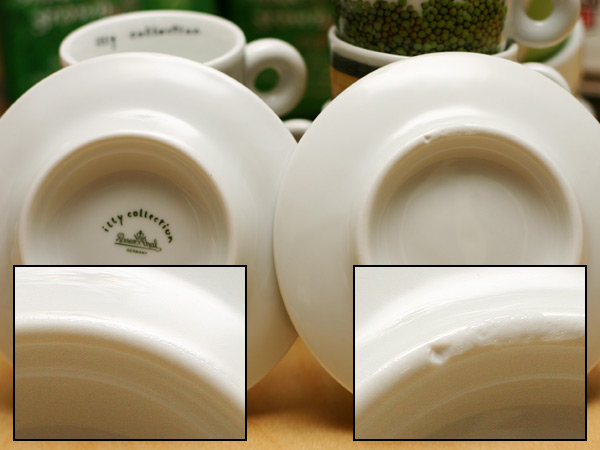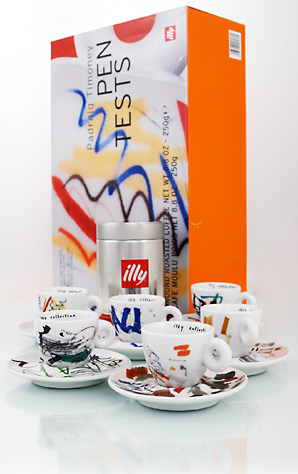Way back once upon a time, I wrote a detailed evaluation for a variety of espresso cups. If you go back and re-read it, you’ll see I was very high on the illy cups in the shootout, but I harped on the lighter weight and the thinner porcelain as compared to other espresso cups.
It’s my opinion that the illy espresso cup, as designed by Matteo Thun, is about as close to perfect as you can get in an espresso cup, when evaluating aesthetics, ergonomics, and finish. Even in materials used – they commission some of the best porcelain companies in Europe – things are a rocking. But since the cup was introduced, it missed one thing. Thickness.
An illy Cup Primer
illy doesn’t actually make their espresso cups. They source out the work of crafting them to three companies – IPA in Italy, and Metternich and Rosenthal, two German porcelain manufacturers.
In addition, illy has two different “runs” of cups – the art series cups which are made to higher standards (but more delicate), and the “bar set” cups, which are designed for commercial use, heavier, and more durable, while giving up some of the finishing qualities the art sets might have. IPA pretty much exclusively does the bar sets, but all three companies do various series of the art collection sets.
I own about fifty different illy art collection sets, and have seen the work by all three companies. I have to give the nod to Rosenthal for the best overall quality – I’ve never seen a bad seam, cut, edge or finish on any Rosenthal work. Metternich is a close second, though I sometimes see defects, and where the Rosenthal cups generally have a nicely rounded “donut” handle, the Metternich work has a slightly dimpled handle – I prefer the former.
IPA, in my opinion, lags quite a bit behind these two German companies in terms of finish, polish and perfection in their work. This is not to say IPA produces bad porcelain – it’s just not at the super high level that Rosenthal has set. IPA art series cups tend to be thicker, but the edges aren’t as nicely finished, nor are the joints and such.
Where Rosenthal pays exacting attention to things like the bottom rim of the saucers (the part that touches the table), IPA pays little finishing attention to this part.



IPA does have the other two beat in one aspect: their porcelain, in the art series cups in the past, tend to be thicker and heavier.
Why Thickness in Espresso Cups is Good
Espresso’s a fleeting thing. And it’s tiny – between 0.75 and 3.0 ounces for a double shot, depending on if you’re a ristrettohead or a traditionalist. If you know anything about thermal dynamics (and I know very little), you know that that small volume of liquid can be greatly affected by exterior temperature influences. Espresso is ideally brewed between 197F and 204F at sea level – That means that, on top of brewing water that has to be at that temperature, the grouphead and portafilter have to be as hot to maintain the water temperature as it flows through the bed of coffee. You do get help in one regard – brewing water hits the bed of ground coffee at 135psi, but it’s at normal atmospheric pressure only 3/4 of an inch lower in the filter – what happened to all that energy? The fineness of the grind dissipated it. And, that very action has a minor (very minor) release of heat – something to do with Einstein. So things are good – by the time the brew water is through the bed of coffee, it’s still at a good click – maybe 190F or so.
You wouldn’t drink 190F liquid, right? You’d scald yourself. But you can drink a perfect espresso right after it’s brewed. That’s because the serving temperature is at the edge of tolerance for most people’s heat sensitivity in the mouth. For many, that’s around 150-160F or thereabouts, so what happened to the 190F brewing?
Many factors. First, we’re dealing with a tiny amount of liquid here – and anything external will affect the temperature – usually by lowering it. The passage from the bottom of the bed of coffee into the bottom of the portafilter, and into the spouts is enough to reduce the Farenheits.
Then there’s that monumental drop (all things relative) from the spouts into the cup – it may be only a couple of inches to you, but to the espresso and its ability to retain temperature, it’s like falling over Niagara Falls (just look at the photo at the start of this article!). Then there’s the cup.
Here’s where you must have things going good – temperature wise. Those cups must be hot – 130-150F hot if possible. If you put a room-temperature cup under those spouts, I guarantee you that 1 ounce of liquid that falls into it will be tepid by the time you drink it. All that porcelain acts as a massive heat sink to the espresso – if it’s 70F, it will leech off substantial percentages of the espresso’s remaining temperature.

And thin cups are especially susceptible to the point where even preheating is not enough. I have some really thin porcelain – the Francis! Francis! Cups. I’ve done side by side tests with the thickest cups I have – balloon tire cups from La Marzocco (about 5x the thickness of the FF cups). Both cups were placed in boiling water to preheat. Both cups were removed, dried at the same time and placed under either spout, then espresso was brewed simultaneously into both cups. The espresso was then sampled, as close in time to each other as possible, and the LM cups had a hotter beverage.
The bottom line is this – espresso’s tiny. It needs thick, well constructed porcelain that is properly preheated to deliver the perfect goods. Which brings me back to…
illy’s Getting Thicker!
I’ve been measuring the weight of a variety of illy art cups from various years. Cup sets from the mid nineties averaged these weights:
- IPA: 118g
- Metternich: 105g
- Rosenthal: 108g
But cup sets from 2000 and 2001 averaged these weights:
- IPA: 124g
- Metternich: 112g
- Rosenthal: 116g
Good trend, but not good enough. That LM cup I talked about above? 178.4g. And some of my favourite “weight” cups, the Ancap cups used by Elektra and Intelligentsia Coffee come in at 170g.

But now for the good news. I’ve noticed a trend in the illy cups especially as of late. IPA seems to be the “go to” company for illy this year, and three sets have been made by them. IPA has not only been jacking up the weight of their art cups, but the thickness increase in the cup walls is evident to the naked eye. The two most recent cup sets I’ve gotten are the Dreams and Conflicts cup set, and the Pen Tests cup set, both by IPA. Dreams weighs in at an impressive 146.4g and the average weight of the Pen Tests cups is 142.1g. A third cup (single cup In Principio) weighs in at 136g (all weights sans saucer).
Rosenthal’s 2003 cups also seem to be a bit heavier – the average weight of the Haim set is around 120g. Still not near the 170+g of other cups, but the upward trend continues. The best news is the IPA cup weight and thickness. IPA still isn’t finishing their cups nearly as well as Rosenthal is doing, but they seem to be getting slightly better, at least in the seams where cup meets handle.
illy “gets” so many things about espresso (pods notwithstanding; if I can go off on a mini rant here, it’s my opinion that illy still does pods as much as they do because a) they have too much research bux invested in it, and b) they make way too much money off it. In my opinion, even illy has a price). They know about the art of extraction and temperature importance; they are sometimes the sole Italian “authority” that talks about the importance of tamping; they push the scientific envelope on finding out exactly what happens inside that portafilter, then they share the information with the world. All good.
But for the longest time, they didn’t seem to “get it” when it comes to their espresso cups, and the importance of thickness. What’s really great with sets like the 146g Dreams and Conflicts espresso cup, illy finally seems to be “getting” it in this regard as well.
Now if they could only convince Rosenthal to jack up the weight of their cups to 160g or so, and increase the thickness. Either that, or kick IPA in the butt to match Rosenthal’s exquisite finishing work.
























